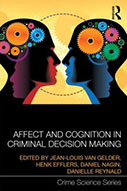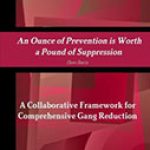Affect and Cognition in Criminal Decision Making

Editors: Jean-Louis Van Gelder, Henk Elffers, Danielle Reynald and Daniel Nagin
Publisher: Abingdon, Oxon, UK; New York: Routledge, 2014. 264p.
Reviewer: Benoit Leclerc | September 2014
It is true that affective states play a role in human decision making. To believe otherwise would be to overlook a well-established fact. A mother, for instance, may choose not to allow her son to play in the park if she is angry at him. A waitress may decide to not provide good service to a customer who is rude to her. Most people decide not to steal from others because of the shame and guilt they would experience if caught. Many women make the decision to not go out alone at night for fear of being victimized. Thousands of examples can be used to illustrate the point. Yet despite the abundance of research in psychology which demonstrates the importance of affective states in decision making, criminologists have rarely looked into this fascinating facet of offender decision making. In Affect and Cognition in Criminal Decision Making, Jean-Louis Van Gelder, Henk Elffers, Danielle Reynald and Daniel Nagin report a series of studies to convince criminologists of the need to incorporate affective states into offender decision making research.
The first four chapters alone of this collection provide the reader with a strong sense of the relevance of such criminological research. Chapter 1 (by Van Gelder, Elffers, Reynald and Nagin) introduces the reader to key concepts and distinctions in offender decision making. The first important distinction is made between different experiences of feelings which include emotions, moods and visceral factors. Essentially, emotions are intense, focused, short-lived and often caused by a particular event. In contrast, moods are longer lasting, less focused and not linked to any particular cause or event. Visceral factors refer to affective states that can take over one’s behavior at higher intensities. These factors include sexual arousal, hunger, pain and drug craving. A fine and rare distinction is also made between anticipated and immediate affect. Anticipated affect refers to affective states that will be experienced at some point in the future whereas immediate affect is experienced at the time of decision making. This contribution is essential because it establishes the main foundational concepts onto which the rest of the collection is based.
Chapter 2 (by Clarke) proves the most logical start to this edited volume after the introduction. This contribution clearly highlights the key decisions made by Cornish and Clarke throughout the years in the development of the rational choice perspective. Clarke also recognizes the role of affective states in offender decision making and proposes a template for researchers to follow for incorporating what is known about this area of research in the rational choice perspective. In this endeavor, however, Clarke stresses that researchers should bear in mind the need to link this body of knowledge to crime policy. When reading this chapter, I felt absorbed into this criminological enterprise.
Chapter 3 (by Topalli and Wright) examines the process of decision making by predatory street offenders. Using a sample of active predatory street offenders, this contribution not only provides a captivating account of the dynamic interplay between different affective states such as desperation, anger and fear in shaping offender decision making processes, but also offers interesting insights into street crime more broadly. Topalli and Wright argue that predatory street offenders can only take so much over time. Constantly exposed to particularly stressful conditions due to their lifestyle, street offenders become more concerned with satisfying pressing needs such as money, which lures them into a state of desperation. In this context, their decision making becomes less rational, which increases (and maximizes) their likelihood of engaging in crime. How anger and fear operate on the decision making process of these offenders is also well illustrated with qualitative offender self-reported data.
Chapter 4 (by Lindegaard, Bernasco, Jacques and Zevenbergen) looks at emotions experienced by robbery offenders across the crime event (i.e., prior, during and after the crime). This investigation is simple and innovative. Using offender self-reported data, this contribution makes a strong argument in favor of the volatile nature of offender affective states during crime, which taps into the importance of understanding the context within which offenders commit their offense. The five most frequently reported emotions by robbery offenders are happiness, challenge, shame, anger and fear. Interestingly, fear is the most frequent emotion experienced in all phases of a robbery. Another example is that while happiness increases during the phases of the event, challenge decreases. Coupled with qualitative data used to explain these findings, this chapter reveals the ups and downs of emotional states of robbery offenders throughout the crime-commission process.
Chapters 5 and 6 investigate the role of sexual arousal on offender decision making using a sample of university students. The originality of Chapter 5 (by Bouffard) rests in that it considers that women’s decision making too is influenced by states of sexual arousal. For both men and women, it is found that arousal level is related to increased perception of benefits from various forms of sexually coercive behavior. At the same time, arousal level reduced the deterrent effect of costs on the use of any sexual coercion tactics. It is interesting to learn that the impact of sexual arousal on the decision to use sexual coercion is similar between women and men.
Chapter 6 (by Exum and Zachowicz) examines the influence of sexual arousal on the endorsement of sexually forceful behaviors as well as the accessibility of perceived consequences of sexual assault. Sexually aroused participants identified a greater number of benefits and accessed them more quickly, and were more likely to endorse sexually forceful behaviors compared to non-aroused participants. This chapter supports the importance of conceiving offending strategies as instrumental behaviors to understand offender decision making, which hits directly at the core of the rational choice perspective.
Chapter 7 (by Wortley and Smallbone) examines the role played by sexual arousal in the first ever child sexual offense committed in a sample of convicted adult sexual offenders. It is reported that sexual arousal is related to sexual orientation, a few victim characteristics, and to some extent, to a range of sexual behaviors performed during the offense. The key aspect of this study, however, involves the investigation of the relationship between sexual arousal and the decision to offend. Offenders who acted impulsively did not report a higher state of sexual arousal than those who planned their offense, which suggests that sexual arousal may be associated with distal rather than proximal decision making even for first-time offenders. A number of plausible interpretations are made by the authors to explain this finding, which taken together, mostly tap into the difficulty of using offender self-reported data to capture such a phenomenon. Despite the challenge to explore the role of sexual arousal in child sexual crime events, this study makes a much needed contribution in a field that often fails to remember that investigating the circumstances into which sexual offenses are committed is remarkably informative in further advancing our understanding of sexual offending.
Chapters 8 and 9 are a testament to the importance of making the distinction between anticipated and immediate affective states. The former contribution (by Kamerdze, Loughran and Paternoster) focuses on the concept of anticipated regret and its impact on decisions to cheat during an exam or drive while drunk. Also using a sample of university students, this discussion indicates that anticipated regret can act as a potential deterrent of deviant behaviors. Specifically, anticipated regret at some time in the future can influence decision making in the present. The latter contribution (by Van Gelder, Reynald and Elffers) looks at whether and to what extent feelings of anger influence the impact of anticipated shame on the decision to offend. With a sample of university students, and using a novel analytical approach to examine the combination of anger and shame on decision making, this contribution shows that anger mutes the effect of anticipated shame on offender decision making. The authors justifiably argue that examining the interaction between different affective states can substantially boost our understanding of offender decision making.
Chapter 10 (by Shalvi, Van Gelder and Van Der Schalk) uses also a sample of university students to analyze the decision making process underlying the unethical behavior of lying. This work demonstrates that anger leads ordinary people to act unethically. Anger can drive a person to dishonestly disadvantage the person who s/he thinks is responsible for evoking this state of anger. In other words, when angry, people are likely to take out their revenge on others at the cost of adopting unethical behaviors.
Chapter 11 (by Treiber) traces back the decision making process to the role of neurocognitive functioning of two brain regions associated with intuitive (dorsolateral region) and emotive (ventromedial region) processes on young people’s involvement in crime. In a thorough demonstration, it is shown that the functions exercised by these brain regions support people’s morality and the ability to exercise self-control – two important dimensions involved in offender decision making. The findings also go so far as to suggest a more critical role played by affective processes compared to cognitive ones.
Chapter 12 (by Tibbetts), again using a sample of university students, turns the spotlight to affective states of empathy, pride, shame and guilt and looks at how these states operate at both state-level (i.e., situational level) and trait-level (i.e., dispositional level). The originality of this piece also comes from the inclusion of affective states such as empathy and pride. It is shown that empathy and pride are positively related (in an inhibitory way) to intentions to offend at both levels. The impact of shame, however, operates only at the state level. This contribution should hopefully encourage researchers to emphasize the role of a wide range of positive emotions on offender decision making.
In the end, I found myself quite happy with most of the contributions included in Affect and Cognition in Criminal Decision Making — especially those using data obtained from actual offenders. Even though a large number of studies used a sample of university students to investigate the role of affective states in offender decision making, they still were able to showcase the critical role of this dimension. Some traditional criminologists may not be attracted and comfortable with the idea of looking at affective states, especially since this implies recognizing that offenders may be driven by positive emotions, and scrutinizing the role of visceral factors such as sexual arousal and drug craving for specific types of offenses. If this is the case so be it. Personally, the editors (and contributors) convinced me of the critical importance of this field in criminology.
Benoit Leclerc, PhD, Senior Lecturer, School of Criminology and Criminal Justice, Griffith University


